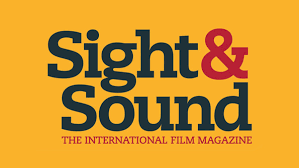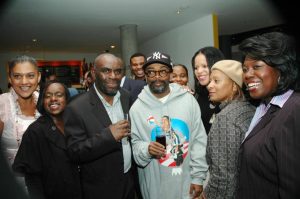
Nadia Denton, film curator, producer and former director of Black Filmmaker Magazine International Film Festival, reflects on the legacy of the world-renowned festival founded by her late father, Menelik Shabazz
14 February 2022

Above Menelik Shabazz and Spike Lee at the 2008 bfm International Film Festival
My entry into the film industry started unintentionally. In 2003 Jane Giles, then programme manager at the Institute of Contemporary Arts, invited Black Filmmaker Magazine, known by many simply as bfm, to curate a film club at the ICA, as a method of building audiences for the annual film festival. I was tasked with coordinating the monthly event by my father. At that point I could never have imagined that it would result in a personal dedication to cinema that has spanned nearly two decades.
The bfm International Film Festival was a dynamic showcase of genre-crossing cinema from the Black world. Narratives from the UK, Caribbean, Africa, Europe and the US all sat neatly next to one another. It was ahead of its time in how it uniquely presented the Black experience to audiences. The bfm strapline at the time was: “Bringing the unseen to light.” Simply put, it was accessible and engaging for the curious who wanted to see more culturally nuanced, less commercial depictions. In a short space of time, it quickly became a hub for international talent who recognised the value of showing their work to underserved UK audiences.
From its inception in 1999 and in the years to follow, bfm screened hundreds of films in London (and also later Birmingham) at a number of venues, including the ICA, Prince Charles Cinema, Odeon West End, Rich Mix, BFI Southbank and the Rio Cinema. Introducing UK audiences to film content that had never been seen, bfm importantly brought new demographics to these venues and was a forerunner in driving mainstream venues to actively welcome more diverse audiences.
 The roll-call of filmmakers whose works were profiled at the bfm festival during its ascendancy reads as a who’s who of the Black indie film world. Among the featured directors were Sir Horace Ové (Playing Away), Kolton Lee (Cherps), Ishmahil Blagrove Jr (Hasta Siempre, Roaring Lion), Julius Amedume (A Goat’s Tail), Owen Alik Shahadah (500 Years Later, Motherland), Clint Dyer (Pukka), Q (Deadmeat) and Wayne G. Saunders (Perfect Girl, The System). The late Earl Cameron, one of the first Black actors in the British film industry, was one of bfm’s longstanding patrons.
The roll-call of filmmakers whose works were profiled at the bfm festival during its ascendancy reads as a who’s who of the Black indie film world. Among the featured directors were Sir Horace Ové (Playing Away), Kolton Lee (Cherps), Ishmahil Blagrove Jr (Hasta Siempre, Roaring Lion), Julius Amedume (A Goat’s Tail), Owen Alik Shahadah (500 Years Later, Motherland), Clint Dyer (Pukka), Q (Deadmeat) and Wayne G. Saunders (Perfect Girl, The System). The late Earl Cameron, one of the first Black actors in the British film industry, was one of bfm’s longstanding patrons.
 While Menelik Shabazz was its principal figurehead, the festival was also directed by notable industry figures, including Charles Thompson (Screen Nation Film and TV Awards), Emmanuel Anyiam-Osigwe (British Urban Film Festival) and Priscilla Igwe (New Black Film Collective). Other individuals who made significant contributions to bfm and who went on to create their own similarly inspired platforms include Joy Coker (Alt Africa) and Marlon Palmer (Kush Film Boutique).
While Menelik Shabazz was its principal figurehead, the festival was also directed by notable industry figures, including Charles Thompson (Screen Nation Film and TV Awards), Emmanuel Anyiam-Osigwe (British Urban Film Festival) and Priscilla Igwe (New Black Film Collective). Other individuals who made significant contributions to bfm and who went on to create their own similarly inspired platforms include Joy Coker (Alt Africa) and Marlon Palmer (Kush Film Boutique).
For Menelik Shabazz, the bfm empire was the ultimate expression of his pan-African ideals. It became a platform on which he could centrally place himself as an authentic voice of Black British filmmaking; a man of Caribbean (Barbadian) descent who saw himself as a son of Africa. Not only was he able to showcase the work of friends and contemporaries across the Black Atlantic, who included Haile Gerima, Julie Dash and Ousmane Sembène, it also allowed him more actively to advocate for the visibility of the Black image both in front of and behind the camera, with heightened international relevance.
Shabazz’s notable film works prior to bfm – Burning an Illusion, Blood Ah Go Run and Time and Judgement: A Diary of a 400 Year Exile – were primarily located within the UK film landscape. Via bfm, Shabazz and his many collaborators presented a pan-African world vision without alienation. Audiences could immerse themselves in the perspectives they saw in print and on screen. It was these keen audiences who in a sense gave bfm events a distinct flavour as an intergenerational gathering of Black world culture.
Both bfm International Film Festival and bfm Film Club sprang from the bfm magazine, Shabazz’s brain child. It reflected his reverence for the written word and love of literature. A bi-monthly publication, it celebrated Black film stars, while critiquing the industry both in the UK and abroad. Leading figures such as Melvin and Mario Van Peebles, Pam Grier and Sophie Okonedo were featured on its covers. Ultimately, the costs of print publishing led the magazine to morph into a blog.
Reflecting on my father’s legacy, it is without question that he was a trailblazer in the development of audience appetites for cinema, and bfm’s unique multi-platform approach across the magazine, film club and festival allowed it to appeal broadly to different tastes and habits. Our events enhanced the audience’s film literacy and gave hope to emerging Black British filmmakers who eagerly sought validation from homemade audiences, while challenging the dominance of film content churned out by the American studio system. In my own career, bfm has influenced my willingness to embrace the niche, while always affirming the audience with an insatiable appetite for Black world cinema.
Sign up and stay informed of my forthcoming events.